
By Lelo Macheke
Almost 20% of South African children between the ages 0 - 5 years are stunted (preventing growth and proper development), while one in three children that have died in hospitals between 2005 and 2009 were malnourished. Stunting is indicatively linked to malnourishment, but more so to poverty for townships and rural areas.
This is according to research done by Labour studies senior researcher Dr Michael Rogan, presented as part of the Labour Studies Seminar Lecture Series hosted by the Neil Aggett Labour Studies Unit (NALSU), with the respective Departments of Sociology, History, Economics and Economic History.
Dr Rogan presented research he conducted on Stunting within the South African population. It indicates that stunting in South Africa is worsening due to the weakening state of the economy; poor service delivery, restricted access to varieties of foods and nutrition knowledge and, diseases.
“People may not realise the extent of stunting in South Africa because they may be thinking of an extremely thin, starving child,” she says. “But it’s not always that. Thinness alone may indicate very acute malnutrition, but in the case of chronic malnutrition, it may be indicated more by height, or the thinness may be masked by short stature.” Some forms of poor nutrition may also involve obesity, or “hidden hunger”, says Peter.
It is important to note that stunting is not only a physical symptom – it is a biological marker that often indicates numerous systemic vulnerabilities – ranging from food insecurity to poor access to sanitation and clean water, which may cause gastric illness that worsens malnutrition.
“Location has a major influence on the state of malnourishment in South Africa. Stunting and other consequences of malnourishment are primarily caused by poverty, which unfortunately is concentrated in specific homelands in the country,” he said.
This is a concerning state of affairs for these areas that are predominantly the original food growers, especially healthy organic food. Dr Rogan suggested that communities must initiate self-sustaining feeding programs and find farmland that is suitable for growing crops.
“We also have to ensure that people are empowered intellectually and with the adequate infrastructure in order for them to reap a healthy harvest,” he stated.
Land and its distribution remains complex, as there is yet to be a national nuanced policy that effectively combines arability research with social justice empowerment schemes to produce a culture of healthy and generational self-sustenance.
“The unfortunate truth remains that people that belong to higher earning income brackets or live in urbanised areas are more likely to have access to a healthier variety of foods than those that do not fit into these categories or farm their own food.”
Other issues relating to stunting where raised by the attentive audience of students and academics based on their personal interactions and associations. Examples of what causes malnutrition are linked to gender dynamics, cultural practices, preferences and economic power disparities.
Lesser but related social causes also include the survival mode that grips South Africans daily, making knowledge and the practice of dietary and health living become a luxury.
Dr Rogan acknowledged the challenging and complex nature of malnutrition and eventual stunting in South Africa, stating that the road ahead is ‘still very long’.
South Africa ranks 70th out of 132 countries for stunted growth rates in the third Global Nutrition Report, released at the end of 2016. It found that South African children were worse off than their counterparts in many poorer countries, including Haiti, Senegal, Thailand, Libya and Mauritania.
Last year, World Bank President Jim Yong Kim vowed to name and shame governments at the World Economic Forum which failed to commit to eradicating stunting by 2030 as it is costly to overlook.

